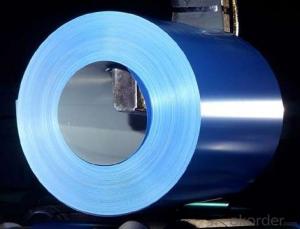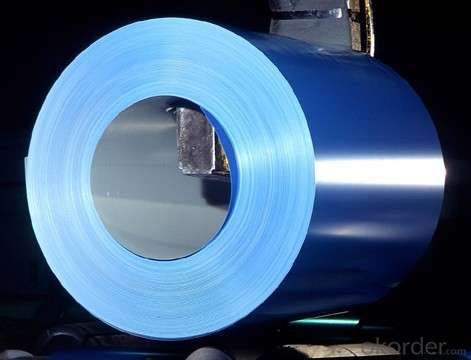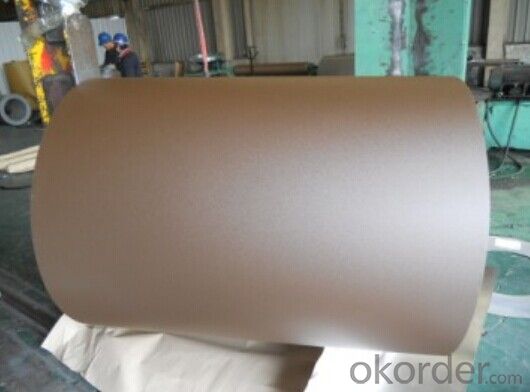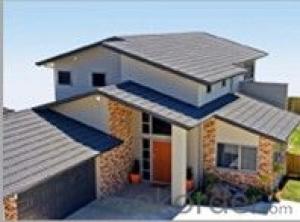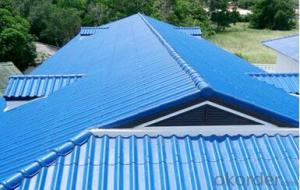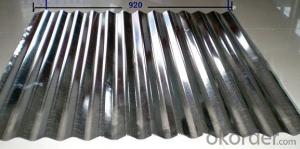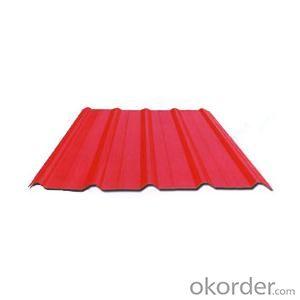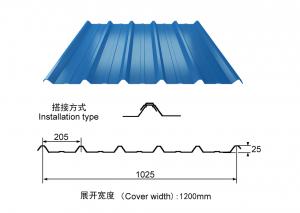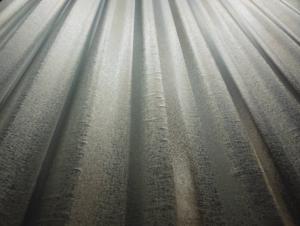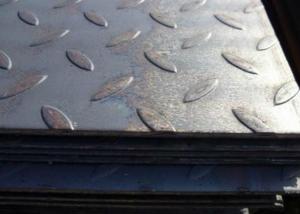Prepainted Galvanized Steel Sheet in High Quality
- Loading Port:
- Shanghai
- Payment Terms:
- TT OR LC
- Min Order Qty:
- 100 m.t.
- Supply Capability:
- 10000 m.t./month
OKorder Service Pledge
OKorder Financial Service
You Might Also Like
1. Pre-Painted Galvanized/Aluzinc Steel Coil Description:
With GI as base material, after pretreatment (degrease and chemical treatment ) and liquid dope with several layers of color, then after firing and cooling, finally the plate steel is called pre-painted galvanized (aluzinc) steel. Pre-painted galvanized steel is good capable of decoration, molding, corrosion resistance. It generally displays superior workability, durability and weather resistance.
2.Main Features of the Pre-Painted Galvanized/Aluzinc Steel Coil:
• Excellent process capability
• Smooth and flat surface
• Workability, durability
• Excellent heat resistance performance
• High strength
• Good formability
• Good visual effect
3.Pre-Painted Galvanized/Aluzinc Steel Coil Images
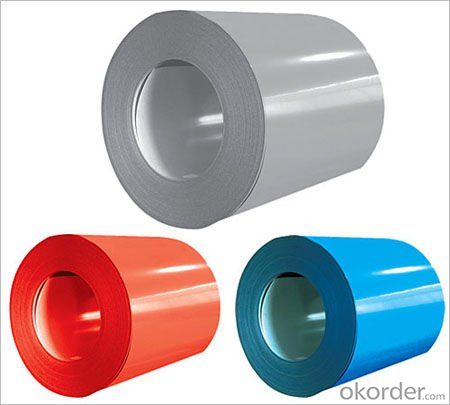
4.Pre-Painted Galvanized/Aluzinc Steel Coil Specification
Standard: AISI, ASTM, BS, DIN, GB, JIS
Grade: DX51D, DX52D
Thickness: 0.17-2.0mm
Brand Name: KMRLON
Model Number: coil
Type: Steel Coil
Technique: Cold Rolled
Surface Treatment: Coated
Application: Boiler Plate
Special Use: High-strength Steel Plate
Width: 20-1250mm
Length: customized
commoidty: pre-painted galvanized steel coil
Thickness: 0.13-4.0mm
width: 20-1250mm
zinc coating: 40-180g/m2
printing thickness: top side: 20+/-5 microns, back side: 5-7 microns
color: all RAL color
surface treatment: color coated
coil weight: 4-7 tons
coil ID: 508/610mm
packaging: standard seaworthy packing
5.FAQ of Pre-Painted Galvanized/Aluzinc Steel Coil
1. What’s the application of this product?
Roof, roof structure, surface sheet of balcony, frame of window, etc.
2. What’s the brand of the paint?
We use the best brand of all of the word—AKZO.
3. How about your company?
A world class manufacturer & supplier of castings forging in carbon steel and alloy steel,is one of the large-scale professional investment casting production bases in China,consisting of both casting foundry forging and machining factory. Annually more than 8000 tons Precision casting and forging parts are exported to markets in Europe,America and Japan. OEM casting and forging service available according to customer’s requirements.
4. How to guarantee the quality of the products?
We have established the international advanced quality management system,every link from raw material to final product we have strict quality test;We resolutely put an end to unqualified products flowing into the market. At the same time, we will provide necessary follow-up service assurance.
5. How long can we receive the product after purchase?
Usually within thirty working days after receiving buyer’s advance payment or LC. We will arrange the factory manufacturing as soon as possible. The cargo readiness usually takes 15-25 days, but the shipment will depend on the vessel situation.
- Q: How are steel sheets tested for hardness?
- Various methods are employed to test the hardness of steel sheets, with one of the most commonly used being the Rockwell hardness test. In this test, a known force is applied to the steel sheet's surface using a small indenter, typically a diamond or a hardened steel ball. The resulting depth of penetration is then measured and standardized to determine the hardness value. Another method utilized is the Brinell hardness test, which involves pressing a hardened steel ball into the steel sheet's surface under a specific load. The diameter of the resulting indentation is measured and used to calculate the hardness value. Furthermore, the Vickers hardness test employs a pyramid-shaped diamond indenter. Similar to the Rockwell test, this method measures the indentation produced, but instead of focusing on the depth of penetration, it determines the hardness value by measuring the diagonal length of the indentation. These hardness tests yield significant insights into the mechanical properties of steel sheets, including their resistance to deformation and wear. By ensuring that the steel sheets meet the required specifications, the test results enable their use in various applications where hardness plays a critical role.
- Q: What is the process of galvanizing steel sheets?
- Galvanizing steel sheets involves immersing them in a bath of molten zinc, which creates a protective coating on the surface of the sheets. This process, known as hot-dip galvanization, helps to prevent rusting and corrosion, making the steel more durable and long-lasting.
- Q: Can steel sheets be used for agricultural buildings or barns?
- Agricultural buildings or barns can indeed make use of steel sheets. The utilization of steel sheets for such structures offers a plethora of benefits. To begin with, steel is a robust and enduring material, guaranteeing the longevity of the agricultural building or barn even in the face of various weather conditions and the test of time. Additionally, steel is resistant to pests, such as termites, which often pose significant problems for wooden structures. Moreover, steel sheets possess fire-resistant qualities, thus providing an extra layer of safety. Furthermore, steel sheets allow for a high degree of customization, enabling flexibility in design and construction. They can be easily cut and shaped to suit the specific needs and requirements of the agricultural building or barn. Steel sheets are available in various thicknesses, offering options for different levels of strength and structural integrity. In addition, opting for steel presents an environmentally friendly choice for agricultural buildings or barns. This is due to steel being a recyclable material, meaning that it can be repurposed and reused at the end of its lifespan. This not only reduces waste but also minimizes the environmental impact. Taking all these factors into consideration, it is evident that steel sheets are an excellent option for agricultural buildings or barns, given their durability, resistance to pests, fire resistance, customizability, and environmental friendliness.
- Q: What are the common sizes of steel sheets?
- The common sizes of steel sheets vary depending on the specific application and industry. However, some common standard sizes include 4x8 feet, 4x10 feet, and 5x10 feet. These dimensions provide a general idea, but it's important to note that steel sheets can be customized to meet specific requirements.
- Q: Are steel sheets suitable for agricultural equipment?
- Yes, steel sheets are suitable for agricultural equipment. Steel is known for its strength, durability, and resistance to corrosion, making it an ideal material for agricultural machinery that needs to withstand harsh conditions and heavy use. Additionally, steel sheets can be easily shaped and welded to create custom designs for specific farming applications.
- Q: What are the different edge finishes available for steel sheets?
- There are several different edge finishes available for steel sheets, depending on the desired aesthetic and functional requirements. Some of the most common edge finishes for steel sheets include: 1. Mill Edge: This is the standard edge finish that comes directly from the steel mill. It is a rough, unfinished edge that has not been further processed or smoothed. It is typically used for applications where the edge appearance is not critical, such as in industrial or structural applications. 2. Trimmed Edge: In this edge finish, the rough mill edge is trimmed or sheared to remove any irregularities or burrs. It provides a cleaner and more uniform edge compared to the mill edge, making it suitable for applications where the edge appearance is important. 3. Deburred Edge: This edge finish involves removing any sharp or jagged edges through a deburring process. It provides a smooth and rounded edge, enhancing safety and reducing the risk of injury. Deburred edges are commonly used in applications where handling or contact with the edge is frequent, such as in automotive or appliance manufacturing. 4. Beveled Edge: A beveled edge is achieved by cutting or grinding an angle along the edge of the steel sheet. It creates a sloping or chamfered edge, which can improve the aesthetics and functionality of the sheet. Beveled edges are often used in architectural applications, as they can enhance the appearance and facilitate better jointing or welding. 5. Rolled Edge: This edge finish is created by rolling or bending the edge of the steel sheet to form a rounded or folded edge. Rolled edges provide a smooth and finished appearance, making them suitable for applications where the edge will be visible, such as in decorative or furniture manufacturing. 6. Hemmed Edge: Hemming involves folding the edge of the steel sheet over itself to create a double-layered edge. It provides a strong and finished edge that is resistant to fraying or unraveling. Hemmed edges are commonly used in applications where the edge will be exposed and require added durability, such as in roofing or sign manufacturing. These are just a few examples of the different edge finishes available for steel sheets. Each finish has its own unique characteristics and advantages, allowing for customization based on specific requirements and preferences.
- Q: Can steel sheets be used in construction projects?
- Yes, steel sheets can be used in construction projects. They are commonly used as roofing and wall cladding materials, as well as for structural elements such as beams, columns, and trusses. Steel sheets offer several advantages in construction, including durability, strength, and fire resistance. They are versatile and can be cut, shaped, and welded to meet specific project requirements.
- Q: What is the recommended storage method for the steel sheets?
- The recommended storage method for steel sheets is to store them in a dry and well-ventilated area. It is important to keep the steel sheets away from moisture and direct sunlight, as these factors can cause rust and degradation of the material. Stacking the sheets on pallets or racks, with sufficient spacing in between, can help prevent any potential damage. Additionally, it is advisable to cover the sheets with a protective material, such as a tarp or plastic wrap, to further safeguard them from dust and other contaminants. Regular inspection and maintenance of the storage area, as well as keeping an inventory of the sheets, can help ensure their longevity and usability.
- Q: Are steel sheets suitable for water tanks or reservoirs?
- Yes, steel sheets are suitable for water tanks or reservoirs. Steel is a durable and strong material that can withstand the weight of water and does not easily corrode or leak. It is commonly used in the construction of water tanks and reservoirs due to its reliability and longevity.
- Q: Are steel sheets suitable for interior design applications?
- Yes, steel sheets are suitable for interior design applications. They offer a sleek and modern aesthetic, are durable and long-lasting, and can be customized to fit various design styles. Steel sheets can be used for wall cladding, ceilings, decorative panels, furniture, and other interior elements, adding a contemporary and industrial touch to any space.
Send your message to us
Prepainted Galvanized Steel Sheet in High Quality
- Loading Port:
- Shanghai
- Payment Terms:
- TT OR LC
- Min Order Qty:
- 100 m.t.
- Supply Capability:
- 10000 m.t./month
OKorder Service Pledge
OKorder Financial Service
Similar products
Hot products
Hot Searches
Related keywords
